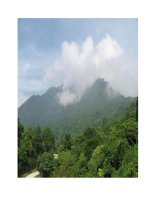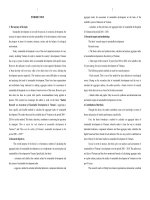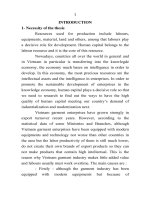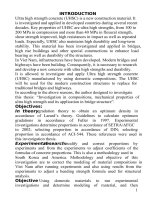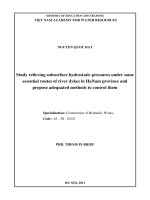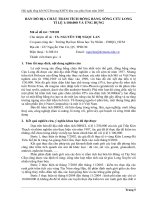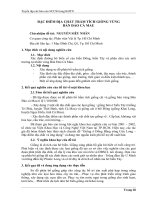tóm tắt tiếng anh nghiên cứu xâm nhập mặn nước dưới đất trầm tích đệ tứ vùng nam định
Bạn đang xem bản rút gọn của tài liệu. Xem và tải ngay bản đầy đủ của tài liệu tại đây (1.43 MB, 27 trang )
i
MINISTRY OF EDUCATION AND TRAINING
HANOI UNIVERSITY OF MINING AND GEOLOGY
HOANG VAN HOAN
SALT WATER INTRUSION IN QUATERNARY
SEDIMENT IN NAM DINH AREA
Specialty: Engineering geology
Code: 62.52.05.01
SUMMARY OF DOCTORAL THESIS ON GEOLOGY
Hanoi, 2014
ii
This thesis has been completed at:
Department of Hydrogeology, Faculty of Geology
Hanoi University of Mining and Geology
SUPERVISORS:
1:
Assoc. Prof. Dr. Pham Quy Nhan,
Hanoi University of Natural Resources and Environment
2: Assoc. Prof. Dr. Flemming Larsen,
Geological Survey of Denmark and Greenland
Judge 1: Assoc. Prof. Dr. Doan Van Canh
Vietnam Association of Hydrogeology
Judge 2: Assoc. Prof. Dr. Nguyen Van Hoang
Vietnam Academy of Science and Technology
Judge 3: Assoc. Prof. Dr. Nguyen Hong Duc
National University of Civil Engineering
Shall be defended before the State level Thesis Assessment Council
held at:
Hanoi University of Mining and Geology
at…… hours, on … …
The Thesis can be further referred to at: National Library of Vietnam
Or Library of Hanoi University of Mining and Geology
1
INTRODUCTION
1. Background of the thesis
Vietnam has a coastline of over 3,260 km and many coastal areas
where are high population, important economic and transportation of the
country. Located in the south east of the Red River Delta, in some
districts of Nam Dinh and Ninh Binh provinces exist ground water lens
in Cenozoic sediments. Groundwater resources are being exploited to
serve the dining, living and production of local people. Potential
exploitable reserves is smaller than demand and water level tends to get
significantly lower (0.5 ÷ 0.7 m/year). The risk of saltwater intrusion has
taken place due to the exploitation of groundwater. In order to sustainable
management groundwater resources. It is necessary to study the
distribution, shape, quality and quantity changes of the fresh water lens
extraction in the area.
2. Purpose and tasks
Purpose:
To study the formation of freshwater lens;
To determine the current status of fresh/saltwater in the Quaternary
sediments in Nam Dinh area;
To identify mechanisms of saltwater intrusion in Pleistocene
aquifer (qp);
To assess the mechanisms impact of salinization process.
Tasks:
To study geological and hydrogeological structure that affect the
formation of freshwater lens;
To analyze and assess the current state of fresh/saltwater
distribution based on the hydrogeological parameters and
geophysics observations;
To study salinity distribution in lowly permeable marine sediment
and its influence to the Pleistocene aquifer;
To identify saltwater intrusion mechanisms of freshwater lens in
Pleistocene aquifer;
2
To develop a mass transport model and to predict saltwater
intrusion.
3. Target and study area
Target: Groundwater in Pleistocene aquifer in Nam Dinh area;
Study area: Freshwater lens in the Pleistocene aquifer at Nam Dinh city
and related areas.
4. Project activities
Determine the current status of saline groundwater distribution;
Do sampling and analyze the surface, groundwater, precipitation and
seawater samples;
Identify mechanisms of saltwater intrusion in Pleistocene aquifer;
Interpret the geophysical and hydrogeologic data;
Conduct drilling, undisturbed soil sampling and squeeze pore water;
Conduct drilling boreholes, and aquifer test;
Develop solute transport models and make prediction of salt
intrusion.
5. Approach and methodology
Approach:
- Practical approach;
- Access to previous research results;
- Access to the evaluation methods of modern investigation.
Methodology:
- Hydro-geochemical method/hydrodynamics: Assess the salinity and
evaluate hydrogeological parameters of the aquifer;
- Geophysical method: determine the formation conductivity;
- Isotopic method: determine the age and origin of groundwater;
- Modeling methodology: forecast groundwater salinization;
- Discussion: discuss and learn from the experts.
6. Scientific and practical significance of thesis
Scientific significance: The thesis contributes to better understanding
the process, the origin and recharge source of freshwater lens.
Mechanisms of saltwater intrusion and the role of these mechanisms in
3
the process of salinization have characterized. The correlation between
the hydrogeological- geophysical parameters, and isotope composition
has established and applied in the study area. The obtained correlation
therefore is applicable for other areas that have similar hydrogeological
conditions.
Practical significance: The thesis has identified the current state of the
saline groundwater distribution, and predict changes of salinity
intrusion in the study area. The obtained results provide valuable
information to the managers, policy-makers and scientists for exploiting
and sustainable use of precious groundwater resources.
7. Research objectives
Objective 1: Freshwater in Pleistocene aquifer in Nam Dinh area is
formed in evolution of geology and hydrogeology of area; the freshwater
lens are continuously recharged by freshwater from lower aquifers in the
west and northwest of Nam Dinh area.
Objective 2: Freshwater lens in the Pleistocene aquifer of Nam Dinh
area is intruded saltwater due to the difference in hydraulic head between
salt and freshwater zones from the north and northeast area; and also due
to recharge from overlying low permeability (marine sediment) layer
through complex chemical and physical processes, in which diffusion
process and density flow play as major roles.
8. The scientific contributions of the thesis
- The results of chemical analysis, isotopic compositions were used in
combination with results of borehole geophysics to determine the
variation of conductivity versus depth and also to analyze the impact of
its processes to the Pleistocene aquifer.
- The thesis has applied geophysics methods and hydrogeological
methods to determine the current status of the distribution of saltwater in
the aquifer and marine sediments.
- The correlation between the chemical composition (Cl
-
, TDS) and
geophysical parameters (conductivity, resistivity of formation) has been
4
determined. This correlation will be used for determining and assessing
groundwater quality through geophysical parameters.
9. Data sources
9.1. Data collection:
Available data and information related to thesis were collected,
including published papers and final project reports.
9.2. Laboratory and field studies results for the thesis only:
The thesis mainly used data sources and field results carried out by
the author and collaborators as following:
Investigation results of the current status of saline groundwater
distribution by the transient electromagnetic sounding (TEM), (61
points) and shallow boreholes (22 boreholes);
Geophysical borehole logging results: 16 boreholes;
Results of aquifer tests in qp aquifer: 03 pumping boreholes;
The results of hydrochemical analysis: 59 groundwater samples and
27 pore water samples;
The results of stable isotopic analysis: 87samples), radioactive
isotopes (32 samples) and isotopes of inert gas (8 samples);
Monitoring water quality and groundwater levels.
10. Structure of thesis
This thesis consists of 160 pages, including 20 tables, 94 figures and
122 references. Structure of the thesis is as follows:
Introduction
Chapter 1: Overview of groundwater salinization study
Chapter 2: The formation of the freshwater lens
Chapter 3: Current state of saline distribution
Chapter 4: Mechanism of saltwater intrusion in Pleistocene aquifer
Chapter 5: Assessment and prediction of saltwater intrusion
Conclusions and recommendations
11. Acknowledgements
This thesis was completed at the Department of Hydrogeology,
Faculty of Geology, Hanoi University of Mining and Geology, under the
5
scientific supervision of Assoc. Prof. Dr. Pham Quy Nhan and Assoc.
Prof. Dr. Flemming Larsen. During the study period, written thesis, the
author has received encouragement and guidance of subcommittee
hearted guide. The author also always get the help from scientists such
as: Assoc. Prof. Dr. Nguyen Van Lam, Assoc. Prof. Dr. Kim Ngoc
Nguyen, Assoc. Prof. Dr. Doan Van Canh, Assoc. Prof. Dr. Phan Ngoc
Cu, Dr. Dang Dinh Phuc, Dr. Dang Duc Nhan, Assoc. Prof. Dr. Nguyen
Van Dan, Assoc. Prof. Dr. Nguyen Van Hoang, Dr. Vu Kim Tuyen, Dr.
Nguyen Thi Thanh Thuy, Dr. Duong Thi Thanh Thuy, MSc. Kieu Thi
Van Anh, Prof. Dieke Postma, Dr. Frank Wagner, Assoc. Prof. Dr.
Christiansen V. Anders, MSc. Vu Long Tran, MSc. Dang Tran Trung,
MSc. Nguyen The Chuyen, MSc. Tran Thanh Le and colleagues in the
VietAS project as well as many officials Scientifics expertise.
Again, the author would like to express my sincere gratitude for all
these valuable help!
Chapter 1 - OVERVIEW OF GROUNDWATER SALINIZATION
STUDY
1.1. Overview of groundwater salinization studies in the world
The synthesis and analysis of scientific works published research
salinization in the world showed that, all the studies were combined
using different methods to solve a particular problem, such as to assess
the current state, determine the cause,
General comments:
The cause of groundwater salinization in different areas can be
varied, depending on its geological, hydrogeological conditions and
geological evolution. These studies have used different methods to
determine the mechanisms of the process groundwater salinization,
Synthesis of studies can be divided into 4 main methods, including:
Hydro-geochemical/hydrodynamics methods;
Isotopic methods;
Geophysical methods;
Modeling methods.
6
1.2. Overview of groundwater salinity intrusion in Vietnam
Pollution of groundwater sources have been interested by scientists
in Vietnam, as there are many topics, study of this issue. Groundwater
salinity intrusion occurs in coastal plains, dunes and islands due to
human activities and natural environment factors.
General comments:
The saltwater intrusion studies are often combined in the evaluation
report of groundwater resources, mainly survey, demarcation survey of
saltwater boundaries with TDS=1g/l and counting the time and speed
movement of boundaries on the basis of geological and hydrogeological
conditions in the study area with exploitation recharge requirements.
On the other hand, studies have also issued a warning about the
possibility of saline into the exploitation works. Synthesis of studies
can be classified into 3 main methods, including:
Hydro-geochemical/hydrodynamics methods;
Geophysical methods;
Numerical modeling methods.
1.3. History of studies on geology and hydrogeology in study area
The studies of geology and hydrogeology in Nam Dinh are always
associated with the study of the history of Red River Plain, besides at
least 20 projects have been done in the area of Nam Dinh. The topics and
projects have showed overall picture of geological and hydrogeological
conditions in Nam Dinh.
Chapter 2 - THE FORMATION OF THE FRESHWATER LENS
2.1. Study area
The study area is located in southeastern of Rid River Delta Plain,
including Nam Dinh and Kim Son provinces, Yen Mo, Yen Khanh, Gia
Vien district belong to Ninh Binh province.
2.2. Geological characteristics of the study area
2.2.1. Stratigraphic characteristics
2.2.1.1. Stratigraphic characteristics Nam Dinh area
7
Proterozoic Eonothem
Proterozoic formations is Song Hong formation, widely distributed in
the study area. Composition: gneis mineral biotite, sillimanite, garnet.
Mesozoic Eonothem
The Mesozoic formation consists mainly in the Triassic, the
composition is limestone, brightly colored, clay limestone, on the
western of study area in Ninh Binh province.
Cenozoic Eonothem - Neogen system - Pliocene series
Including the Vinh Bao and Tien Hung formations. Sediment
composition consists of mainly small to medium sand interbedded with
gravel and slity clay.
Quaternary System
Lower Pleistocene stage - Le Chi formation (amQ
1
1
lc)
The sedimentary of Le Chi formation is not exposed in surface but
can met in the majority of boreholes in the study area. Lithological
composition including silt, fine sand, silty-clay. Distribution depth of
formation from 79m to 132.8m. The thickness varies from 4m to 26.2m.
Middle Pleistocene stage - Ha Noi formation (a, amQ
1
2-3
hn)
The sedimentary of Hanoi formation is widely distributed in the study
area. Lithological composition mostly sand and gravel with ranging from
blue-gray to yellow-gray.
Upper Pleistocene stage - Vinh Phuc formation (a, am, mQ
1
3
vp)
the sedimentary of upper Pleistocene in the study area is Vinh Phuc
formation. Composition is mainly of sand, silt sand and silty clay.
Lower-middle Holocene stage - Hai Hung formation (mQ
2
1-2
hh)
The sediments of the Hai Hung formation is divided into 3 types of
origin. Lithological composition is sand, silt sand with organic matter.
Upper Holocene stage - Thai Binh formations (Q
2
3
tb)
Thai Binh formation is subdivided into two parts. Sediment
composition is mainly of fine-grained sand and silty clay.
2.2.1.2. Stratigraphic characteristics of continental shelf
8
Marine sediments belong to tidal estuary sedimentary in this study
due to tidal. Composition is composed mainly of coarse sand, fine sand,
silt and clay, fine grain which gradually towards the sea.
2.2.2. Structural Characteristics
2.2.2.1. Geological structural characteristics of Nam Dinh area
In the study area exist two major fault systems that are perpendicular
to each other and extend in northwest - southeast (NW-SE) and northeast
- southwest (NE-SW) directions.
2.2.2.2. Structural characteristics of geology in western study area
In addition to the characteristics of the geological formations in the
Cenozoic and pre-Cenozoic, the area was covered with Quaternary
sediments with different geological structures. The faults system extend
in two directions: NW-SE and NE-SW, and the tectonic activities have
divided the area into the lift and drop blocks.
2.2.2.3. Geological structure characteristics of the continental shelf
of study area
The study area is located in the northwestern area of the Red River
sedimentary basin, where there are many major faults oriented NW-SE.
2.3. Hydrogeological characteristics
2.3.1. The aquifers
2.3.1.1. Aquifer of upper Holocene sediments
Distributed throughout the all plain area, components of aquifer
include sand, silty sand of Thai Binh formations.
2.3.1.2. Aquifer of lower Holocene sediments
This aquifer is not evenly distributed throughout the study area, not
exposed on the surface. Components of aquifer include sand, silty sand,
silty clay of Hai Hung formation.
2.3.1.3. Pleistocene aquifer
Describe aquifers distributed throughout the delta area, lithological
composition of aquifer include fine sand, coarse sand and gravel of Vinh
Phuc, Hanoi and Le Chi formation.
2.3.1.4. Pliocene aquifer
9
Widely distributed throughout the study area. Lithological
composition includes sandstone, siltstone, claystone. Groundwater exists
in the form of fracture and porosity.
2.3.1.5. Aquifer of carbonate sediments, middle Triassic
Distributed in the west of study area, reservoir are karst and fracture.
2.3.2. The aquitard
2.3.2.1. The Hai Hung formation
Widely distributed in this study area, component of marine sediment
is clay, silty clay; thickness from 3m to 40m, averaging 13m.
2.3.2.2. The Vinh Phuc formation
Widely distributed in the region, mainly lithological composition is
clay, silty clay of marine sediment in thickness from 7m to 34m.
2.3.2.3. The metamorphic formations
The formations of Song Hong metamorphic complex distributed
across much of the study area. They look like sides of bowl that are
scattered in the mountain areas called Ho mountain, Xa mountain, etc.
2.3.3. Hydro-geochemical characteristics
2.3.3.1. Hydro geochemical characteristics of qh
1
and qh
2
aquifers
Most aquifer qh
2
have TDS>1g/l. The whole investigation points in
study area in qh
1
aquifer TDS>1g/l.
2.3.3.2. Characteristics qp aquifer
Freshwater occupy large areas in the south, southeast, located in the
district of Hai Hau, Nghia Hung and part of Giao Thuy, Nam Truc, Truc
Ninh, Y Yen district, the distribution of freshwater in inland and in the
continental shelf (offshore). Saltwater distribution in the northeast and
was widely popular in the bordering of Thai Binh province. The chemical
composition is mainly sodium chloride.
2.3.4. Geological structure of the study area
The study area is located close to the sea. There are two types of
terrain: Type 1: limestone, average height located in Ninh Binh; Type 2:
flat, located in deep valley Ha Noi, influenced by both river and sea.
10
In the pre-Cenozoic formations had found many tectonic faults
developed in two main direction NW-SE and NE-SW, the fracture
bedrock was divided into blocks of different drop-lifting, in which the
Quaternary cover. The tectonic faults have played a role as the canals
from the highlands of southwestern and underground drainage in the
Neogene and Quaternary formations.
2.4. The process of forming the freshwater lens in study area
2.4.1. Evolution of Cenozoic sediments
Geological, hydrogeological conditions, historical development of
geology, structural elements in geological and hydrogeological factors
determine the natural formation of the freshwater lens.
2.4.1.1. The development phase of Neogene sediments
The sediments of Tien Hung and Vinh Bao formation was created and
filled the low-lying areas. Sediment composition including clay, siltstone,
and sandstone.
2.4.1.2. The development phase of Quaternary sediments
The study area lies at the junction between the plain and the sea. Due
to the interactive effects between the river and the sea, where the pre-
delta is formed.
2.4.2. Assumptions about the formation of the freshwater lens
- In the late Pliocene period, about 1.8 million years before present
(BP), sea water drawn, study area exists continental of Vinh Bao
formation, water supplied by rain directly on this formation, the water
from below aquifer is provided by fracture and karst.
- In early Pleistocene period, sea water rise and formed Le Chi
formation, in the study area became the estuary, the TDS of water higher
in Neogene aquifer at this time.
- In middle-late Pleistocene period, degradation of sea from the
study area, the sea lever is lower than the present sea level with highest
about 120m, forming Hanoi formation. The process of erosion took place
processes strongly as well as river flood sediment deposition, infiltration
11
of rain, river water and water from bedrock, freshwater in Bao Vinh,
Hanoi and Le Chi aquifers.
- In the late Pleistocene, about 14,000 to 15,000 years BP, sea levels
began to rise again, beginning Flandrian transgression period, the
Pleistocene sediments begin immersion by sea water in Nam Dinh
- The Holocene transgression, reaching a maximum value in 6,000
years BP period. When transgression occur, fine-grained sediments were
deposited, they will prevent sea water from the Pleistocene aquifer before
and become confine aquifer.
- The degradation in the Holocene, about 4,000 years BP the sea
level begins dropping, while the hydraulic gradient in the aquifer
increased due to the height difference between the supplying sources
from the western bedrock formations and Quaternary sediments
increased, fresh water flow prevail and replace saltwater in aquifer.
2.5. Groundwater recharge for freshwater lens of study area
2.5.1. Methodology
Application of isotopic techniques combine to study the structure of
geology and hydrogeology determining the direction of groundwater in
the Quaternary formations and earlier in order studying origin of
freshwater and hydraulic relationship between aquifers.
* The origin of groundwater
Deuterium (D or
2
H) and
18
O are two stable isotopes of hydrogen and
oxygen and also the composition of the water molecules. In the natural
isotopic composition of the water will change in the phase transition.
* Groundwater flow determination by using radioactive isotopes
The age of groundwater by isotope technique based on the decay of
radioactive isotopes in the water molecular composition or in the quality
or composition of the minerals dissolved in water.
2.5.2. The study results
2.5.2.1. Stable isotope composition of the water samples
Results analyzed stable isotopes δ
2
H composition changes from
-72.58 to -2.12‰ and δ
18
O from -8.99 to -0.86‰ that showed the origin
of water in aquifer from sea water and meteorological water.
12
2.5.2.2. Radioactivity of
14
C and
13
C stable isotope composition
Radioactivity ratio (
14
a) of the
14
C isotope in dissolved inorganic
carbon (DIC) of the water samples at different depths showed that the
retention time of water in the aquifer is different. Stable isotopes
13
C as
an indicator to determine the initial concentration of the samples.
2.5.2.3. Research results and tritium isotopes of inert gas
The inert gases and tritium isotopes allows to identify the residence
time of water in the aquifer from 0 to 1,500 years. Resident time of
ground water is longer from NW to SE.
2.5.3. Analysis of results and discussion
2.5.3.1. Recharge source and origin of groundwater in study area
Stable isotopes composition of water in the Pleistocene aquifer where
some monitoring stations is recharged from the Neogene and Triassic
aquifers. Groundwater in qp aquifer has origin from rain water.
2.5.3.2. Determination of groundwater flow direction base on the
groundwater dating results
The results of radioactive
14
C isotopic composition analysis and
residence time of water in the Triassic and Neogene aquifer throughout
the study area showing: Residence time of water in the Pleistocene
aquifer reaches the largest with 12,900 years and the shortest time is
1,100 years (fig. 2.1). This freshwater in the center of the funnel has
greatest residence time.
Figure 2.1: Conceptual model of groundwater movement in study area
from isotopic results (profile CD in figure 4.4)
Water in the fractured, karst have directional movement NW-SE and
from the west, north west toward the sea. With the combination of
6.000
11.300
7.400
3.300
3H = 0,7 TU
850
1.100
3H = 0,37 TU
(3H = 2,03 TU)
Present water
0m
-150
-200
-250
D
50
93,6m
12m
100
-100
-300
qp
PR
PR
qp
-50
n¤n¤
- Groundwater age (year)
850
Q108
LK35 Q109
LK54
Q110
Q111
170,6m
80m
150m
248m
aquitard
Fracture zone
Granular aquifer;
100m
n¤
t¤
t¤
GV01
Q92
LK14
Groundwater flow direction
Karst and fracture aquifer;
C
-150
100
50
0m
-50
-100
-200
-250
-300
67m
70m
13
studied on geology, topography, geomorphology, and hydrogeology as
well as isotopes results (
14
C,
3
H,
39
Ar/
40
Ar,
3
He) in the monitoring points
shows the trend more younger water with deeper. Movement of
groundwater from Triassic aquifer to Pleistocene aquifer by three ways:
1) Groundwater from Triassic aquifer recharge directly to qp aquifer;
2) From Triassic aquifer recharge to qp aquifer through Neogene;
3) From Triassic recharge to qp through Proterozoic and Neogene;
Chapter 3 - CURRENT STATE OF SALINE DISTRIBUTION
3.1. Theoretical basis of methodology
The salinity of water depends on the total concentration of dissolved
salts in water. This is demonstrated by the ability of water conductivity.
Therefore, to determine electrical conductivity of water can be estimate
the salinity of water characteristic.
3.1.1. Resistivity of aquifer
Conductivity in sedimentary rock is kind of electronic conductivity
and ionic conductivity, which occurs in the mineral, or in other hand,
transmission element is electron.
3.1.2. The theoretical basis of transient electromagnetic method
Transient electromagnetic soundings TEM study secondary field due
to the eddy current induction occurs in conductive objects in the rest
period of the current pulse.
3.1.3. Theoretical basis of conductivity measurement
Conductivity reflects the electrical capacity of the soils. The essence
of the method that study the phenomenon of electromagnetic induction of
sediment or rock (formation) around the borehole.
3.2. The TEM result
3.2.1. Location survey area
The routing switch is arranged to measure the direction from the Red
River to the sea; route length measurement, position measurement points
and the points measured on the statement depends on results of field
14
surveys conducted before measurements to minimize, avoid noise of the
surrounding environment.
3.2.2. Survey results
Using software SITEM/SEMDI quantitative analysis for the measured
points, combining the analysis results of the chemical composition of
groundwater build regression identified and verified at best limited in
study area. The resitivity limitation of salinity formation is 12.2 ohm.m
(equal to 1 g/L of TDS).
3.2.3. Analysis of results
The first layer: resistivity value is relatively high;
The second layer: play role the transition layer ;
The third layer: a very small resistivity value, from 0.6 to 2.2 ohm.m;
The fourth layer: large range of resitivity, lower resitivity gradually
from west to east;
The fifth layer: resistivity value is relatively high, from 12÷35ohm.m
3.3. Geophysical borehole results
3.3.1. Borehole logging location
The logging boreholes measurement evenly distributed in the study
area, with 16 monitoring boreholes.
3.3.2. The determination results
From the measurement results, analyze the chemical composition of
pore has demonstrated the ability to vary the conductivity of the
sediments depends on the pore water saturation.
3.4. Hydrogeological boreholes investigation results
The results of hydrogeological boreholes to establish the pair
correlation between regression and resistivity values. Also to assess the
status of the saltwater distribution in aquifer.
3.5. Analyzed results of chemical composition of pore water
The analysis results of 27 samples of pore water was squeeze from
marine sediments, evenly distributed in depth, at 02 sampling locations
VietAS_ND02 VietAS_ND01 and clarified the chemical composition,
the ability to identify the correlation of pore water conductivity and the
electrical conductivity of the formation with a high correlation coefficient
15
(R
2
= 0.9262), this result indicates that the electrical conductivity of
marine sediments in Nam Dinh area is dominated by the pore water. The
highest value of TDS of pore water distributed in the middle of marine
sediment layer and lower value toward the surface and bottom layer. The
maximum value reached more than 37g/L (fig. 3.1).
Figure 3.1: Hydro-geochemical cross-section of TDS concentration
distribution of pore water (profile in figure 4.4)
3.6. Summary of saltwater distribution determination
Results composite materials research suggests Nam Dinh area:
- Upper Holocene aquifer (qh
2
) have TDS relatively large, the vast
majority of the value is greater than 1g/L;
- Lower Holocene aquifer (qh
1
) is salty entirely;
- The boundaries of salinity in Pleistocene aquifer in the north and
northeast of the region;
- The survey results show that fine-grained sediments (clay, silty clay)
have very high TDS, and distributed over the entire area of research and
descending on the top and bottom of layer.
Figure 3.2: Conceptual model of salinity distribution
(profile in figure 4.4)
-150
0m
-50
-100
-200
-250
-300
-250
0m
-50
-100
-150
-200
-300
110
qh£
B
Q225A
LK63
150
n¤
Q226N
qh¤
151
170
155
LK55Q227A
qh¤
TuyÕn mÆt c¾t AB
PR
qp
n¤
248
LK54
qh£
LK53 Q228A
120
170
qp
150
qh¤
n¤
Q229N
LK48
LK47
T¤
PR
140
T¤
A
66
G
H
16
Chapter 4 - MECHANISM OF SALTWATER INTRUSION IN
PLEISTOCENE AQUIFER
4.1. Solute transport in groundwater
4.1.1. The processes of solute transport
4.1.1.1. Advection process
Advection is just a fancy word for the movement of mass entrained in
the flow. Solute advection is dissolved substances process by subsurface
flow.
4.1.1.2. Dispersion process
a. Mechanical dispersion process
Mechanical dispersion is the process of solute that moves through the
pore environment.
b. The process of hydrodynamic dispersion
The process of hydrodynamic dispersion consists of two different
processes that combine mechanical dispersion and molecular diffusion.
Parameters characterizing is called the coefficient of hydrodynamic
dispersion (D
L
and D
T
).
4.1.1.3. Molecular diffusion process
When there are differences in differential concentration, calculations
in thesis base on Fick's law in sedimentary environment.
4.1.1.4. The hydro-geochemical processes relevant
The other related process can occur: The reaction acid/base, the
association of ions into the neutral element, the redox reactions, the
process of precipitation, dissolved, the process of absorbing and releasing
(ion exchange process).
4.1.2. Characteristic of salinity movement in groundwater
4.1.2.1. Effect of density to the distribution of saline
Effect of liquid density to the spatial distribution according to the
relationship: H = 40h.
4.1.2.2. Solute transport by the difference in density
Solute transport of density differences mainly affected by gravity.
Darcy's law for solute transport by the effects of density is calculated
17
basis, quantitative assessment of saltwater intrusion to the Pleistocene
aquifer by lower permeability layer (marine origin).
4.2. Mechanism of saltwater intrusion in the Pleistocene aquifer
4.2.1. The general concept and study-oriented for mechanism of
saltwater intrusion in the Pleistocene aquifer in study area
4.2.1.1. The general concept
Mechanism of saltwater intrusion is the way of saltwater intrude into
freshwater body in aquifer or freshwater lens, increasing the
concentration of salt in aquifers or freshwater lens.
4.2.1.2. Study-oriented for mechanism of saltwater intrusion in the
Pleistocene aquifer
Base on reference to study the mechanism of saltwater shows oriented
study is appropriate to clarify the following:
1) In the study area exist any salt sources?
2) Distribution of salinity source compared to study aquifer?
3) Effect of salinity sources to the aquifer?
The results of the study of geology, hydrogeology, geochemistry
shows exist three main sources of salinity are:
- Saltwater distributes on the surface (sea water);
- Saltwater in the same Pleistocene aquifer with freshwater;
- Saltwater in lower permeable marine sediments.
4.2.2. Saline intrusion into Pleistocene aquifer by the influence of
marine sediments
4.2.2.1. The distribution of marine sediments
The distribution of the marine sediments are determined on the basis
of geophysical data combined with borehole drilling materials, in order to
determine the depth distribution of the layer thickness.
4.2.2.2. The distribution of salinity in the marine sediment layer
The results of the analysis and calculation of the salinity distribution
in marine sediment has been showed in Chapter 3. Distribution of salinity
in cross-section G-H (fig. 3.1) showing the highest concentration of TDS
distribution in the from 20m to 30m deep (more than 37g/L) and
descending toward the surface and bottom of this layer.
18
4.2.2.3. Results of stable isotope composition of pore water
The applied isotopic techniques to determine the possibility of mixing
water in aquifers qp (meteorological origin) and sea (marine origin) in
marine sediment. Recently, pore water in marine sediment has both
marine origin, and derived meteorology (fig. 4.2).
0
10
20
30
40
50
60
70
80
90
100
-8 -6 -4 -2 0
δ
18
O (‰ )
Depth (m)
0
10
20
30
40
50
60
70
80
90
100
-60 -50 -40 -30 -20 -10 0
δ
2
H (‰)
Depth (m)
0
10
20
30
40
50
60
70
80
90
100
0 20000 40000 60000
EC (µS/cm)
Depth (m)
Figure 4.1: Distribution of stable
isotope and EC at VietAS_ND01
Figure 4.2: Results of stable
isotope composition
4.2.2.4. Results determined diffusion coefficient
Experimentally determined diffusion coefficient of chloride in marine
sediment on the basis of determining the change of NaCl concentration
over time at the contact surface between and water samples. The average
value obtained for the study area is D
e
= 0.6*10
-9
m
2
/s.
4.2.2.5. Results of SEAWAT model
Results of 1D simulation model describe the distribution of salt
concentration over time with different permeability coefficient, assessing
the impact of the permeability coefficient to distribution and movement
of salt by diffusion and density flow.
4.2.2.6. Mechanism of saltwater intrusion into Pleistocene aquifer
under the influence of low permeability layer
From the measurement results of borehole logging and analysis of the
chemical composition of pore water as well as the correlations shows the
electrical conductivity of formation is dominated by pore water;
measurement results of borehole logging site can be used to determine
(
δ
18
O
)
(
δ
2
H)
(EC)
Pore water
19
the displacement salinity of pore water in marine sediment downward qp
aquifer.
The study results showed that salt movement influenced by two
main processes are molecular diffusion and density flow, the surface
layer is mainly dominated by molecular diffusion and the bottom layer
is influenced by both density flow and molecular diffusion.
Figure 4.3: Distribution of conductivity, chloride, δ
18
O analysis of pore
water and logging results in borehole VietAS_ND01
4.2.3. Saltwater intrusion into Pleistocene aquifer affected by
hydraulic head
4.2.3.1. Grain-size analysis of Pleistocene aquifer
The result of geological survey, analyze of lithology composition in
Pleistocene sediments showing that, lithological composition mainly
sand and gravel with porosity from 0.25 to 0.39.
4.2.3.2. Hydrogeological parameters Pleistocene aquifer
Results of pumping test at 03 boreholes showed that flow rate in
Q227, VietAS_ND02 and VietAS_ND01 Pleistocene aquifer here is high
yield, hydraulic conductivity ranged from 1,264 to 1,549 m
2
/day.
4.2.3.3. Drawdown and flow direction in Pleistocene aquifer
20
Base on the results of the national monitoring network from 1994 to
2012 shows that groundwater level in the Pleistocene aquifer here is
decreasing at rate of about 0.5 to 0.7m/yr.
Hydraulic gradient from saltwater to the freshwater towards the
northern is 0.00042 and northeastern is 0.00039. Movement saltwater
boundaries towards the center freshwater body (fig. 4.4).
2
0
6
0
1
0
0
269.
.180
karst
karst
.389
2
0
0
4
8
9
G
u
l
f
o
f
T
o
n
k
i
n
2
2
5
0
5 Km 10
*
Ground water contouring (m)
Flow direction of groundwater
*
Pleistocene boreholes
Karst, fracture aquifer
Granular aquifer
Sea, river
Legend
LegendLegend
Legend
P
r
o
f
i
l
e
A
P
r
o
f
i
l
e
B
P
r
o
f
i
l
e
D
P
r
o
f
i
l
e
C
GV01GV01
Q108b
Q109a
Q110a
Q92
ND01
ND02
Q221a
Q222b
Q223a
Q224a
Q225a
Q226a
Q227a
Q228a
Q229a
Figure 4.4: Hydraulic head (year 2012) and direction of groundwater
flow of Pleistocene aquifer map in study area
Conclusion: The main mechanisms, the dominant process saltwater
intrusion into freshwater lens in Pleistocene aquifer, Quaternary
sediments of Nam Dinh area includes: 1) Saline intrusion occurs
vertically due to the marine sediment (clay, silt); 2) Saline intrusion
occurs horizontally (in the Pleistocene aquifer) due to draw down, water
level differences between saltwater and freshwater zones (fig. 4.5).
Figure 4.5: Simulation of saltwater intrusion mechanism in the
present time in Nam Dinh area (profile in figure 4.4)
B
Aquitard
Q
Q
Q
Q
TDS < 1g/l zone TDS = 1 - 3g/l zone TDS = 3 - 8g/l zone TDS > 8g/l zone
Q
A
-100
-150
-200
-250
-300
3
g
/
l
3
g
/
l
3
g
/
l
3
g
/
l
3
g
/
l
3
g
/
l
3
g
/
l
3
g
/
l
3
g
/
l
3
g
/
l
3
g
/
l
3
g
/
l
3
g
/
l
3
g
/
l
3
g
/
l
3
g
/
l
3
g
/
l
3
g
/
l
3
g
/
l
3
g
/
l
3
g
/
l
3
g
/
l
3
g
/
l
3
g
/
l
3
g
/
l
qh¤
0m
-50
1
g
/
l
1
g
/
l
1
g
/
l
1
g
/
l
1
g
/
l
1
g
/
l
1
g
/
l
1
g
/
l
1
g
/
l
1
g
/
l
1
g
/
l
1
g
/
l
1
g
/
l
1
g
/
l
1
g
/
l
1
g
/
l
1
g
/
l
1
g
/
l
1
g
/
l
1
g
/
l
1
g
/
l
1
g
/
l
1
g
/
l
1
g
/
l
1
g
/
l
qp
qh¤
PR
n¤
qp
qh¤
n¤
T¤
PR
-250
T¤
-100
-300
-150
-200
0m
-50
Salt water movement
Salinity movement
Fresh water movement
Sal
inity
boundary in qp
Salinity monitoring
location
TEM profile
21
Chapter 5 - ASSESSMENT AND PREDICTION OF SALTWATER
INTRUSION
5.1. Salt water intrusion in Pleistocene aquifer by marine sediment
assessment
5.1.1. Saltwater intrusion due to molecular diffusion process and
density flow
Calculation results of the effects due to molecular diffusion and
density flow ranged from 0.11 to 0.22 g/m
2
/yr.
5.1.2. Limitation of molecular diffusion and density flow processes
5.1.2.1. Terms and conditions occurring diffusion process
The molecular diffusion process in sedimentary environments stopped
when the concentration gradient is 0.
5.1.2.2. Terms and conditions occurring density flow process
Density flow process does not occur in impermeable sediment when
the hydraulic pressure of lower layer is greater than upper layer up to
10m.
5.2. Evolution of water salinization in Pleistocene aquifer affected
by exploitation
5.2.1. Calculating saltwater boundary under observation data
a) Base on result of the current salinity status
The most significant change occurred in the northeast region, the
vibration amplitude reaches 4km for 15 years, reaching speeds of 0.27
km/yr.
Figure 5.1: Monitoring data of chemical composition of groundwater
(monitoring location in figure 4.4)
22
b) Salinity boundary calculation by result of hydraulic gradient
Determine the marginal rate of salt movement on the basis of
hydraulic gradient determined from the boundary to the center of
freshwater lens: northwest direction: 0.029 m/day, to the north: 0.042
m/day; northeast: 0.039 m/day.
5.2.2. Prediction results of saltwater intrusion in Pleistocene aquifer
by numerical models
5.2.2.1. Model of groundwater flow
Based on the stratigraphic borehole survey strata of the national
monitoring, results of construction monitoring works. The Geological
and hydrogeological parameters, model building flow under two
scenarios: stable exploitation volume and increasing trend of population
in study area.
5.2.2.2. The model predicted the salinization of Nam Dinh
In the beginning of the mass transport model obtained in 2012 with
TDS originally obtained as a result of determining salinity distribution.
Scenario 1: Maintaining the current flow extraction saltwater intrusion
assessment in 2020, 2030 and 2050.
Scenario 2: Evaluation of the extraction flow increased saltwater
intrusion assessment in 2020, 2030 and 2050.
Results saltwater intrusion prediction based on the scenario of the
flow pattern. Evolution TDS concentrations at the monitoring location:
The variation observed TDS concentrations over time are given for 3
positions for 3 regions characterized. In general, all monitoring locations
movements TDS has increased in both scenarios.
5.3. The solution, saline intrusion restrict in the Nam Dinh
5.3.1. Remedies, salinization restrictions
The main reason causing saltwater intrusion Pleistocene aquifer is
differential level between the fresh and salt water zones. Therefore,
solutions, salinization restrictions proposed on the basis of two
principles:
- To reduce water level differences between the salt and the fresh;
- To prevent subsurface flow from the salt to the fresh zone.
23
5.3.2. Solution for groundwater exploitation and usage
Solution mining and rational use of groundwater resources in the
region is to convert individual forms of uncontrolled exploitation to
concentrated form. Concentrated groundwater extraction will help
managers adjust, control operators depending on water level changes in
the region and balance the demand.
CONCLUSIONS AND RECOMMENDATIONS
Conclusions
1) The geological structure pre -Cenozoic basement in the study area is
complex and divided into different lifting blocks by NW-SE and
NE-SW major fault systems. Those faults also played as conduits
systems for recharge on which is coated by Neogene and Quaternary
sediments;
2) Several saltwater intrusion processes and fluxing cycle oscillations
of sea water in accordance with sediment evolution have occurred in
the area during the Cenozoic. The process of freshwater lens
formation after beginningFlandrian transgression occurred around
4,000 years BP;
3) Strong correlation between chlorine concentration and, TDS of pore
water with conductivity showed consistent with theory and certainly
the basis for determining the variables change of chloride and TDS
according to the results of borehole logging;
4) Applied TEM method with hydrogeological methods to determine
salt-fresh water interface in Pleistocene aquifer in Nam Dinh area is
appropriate with the hydrogeological conditions and shows reliable
results. This is one of the basic research and research-oriented on the
basis of the data associated with the current state of exploitation in
the region to study the mechanisms of saltwater intrusion;
5) Vertical saltwater intrusion is caused by low-permeability effect of
the marine sediment. The density process is dominated at the place


